Catherine Lee. Being Here / Being There
06 Jun - 09 Aug 2014
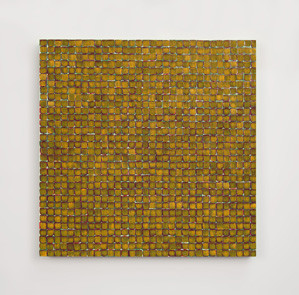
Madder Trumps Green (Quanta #44)
2012
Oil on board
20,3 x 20,3 x 2,3 cm /
8 x 8 in
Titled, dated, signed verso:
Quanta 44 Madder Trumps Green
2012 Catherine Lee
2012
Oil on board
20,3 x 20,3 x 2,3 cm /
8 x 8 in
Titled, dated, signed verso:
Quanta 44 Madder Trumps Green
2012 Catherine Lee
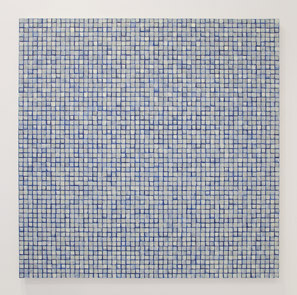
A Far Bright World (Quanta #67)
2014
Acrylic on canvas, on white gesso
213,4 x 213,4 x 7,9 cm /
84 x 84 ins
Signed, titled, dated verso center:
Catherine Lee
A Far Bright World 2014
2014
Acrylic on canvas, on white gesso
213,4 x 213,4 x 7,9 cm /
84 x 84 ins
Signed, titled, dated verso center:
Catherine Lee
A Far Bright World 2014
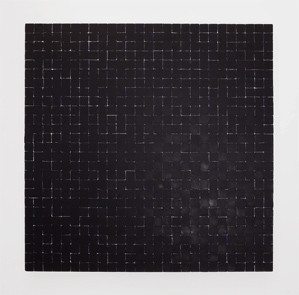
Prussia (Quanta #3)
2011
Pencil and oil on canvas
137,2 cm x 137,2 x 6,5 cm /
54 x 54 in
Titled, signed and dated verso upper left: Prussia (Quanta #3) Catherine Lee 2011
2011
Pencil and oil on canvas
137,2 cm x 137,2 x 6,5 cm /
54 x 54 in
Titled, signed and dated verso upper left: Prussia (Quanta #3) Catherine Lee 2011
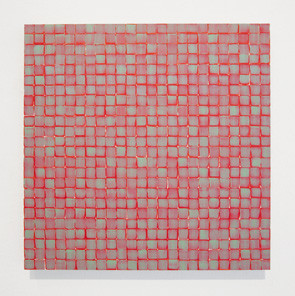
Fiercely Yours (Quanta #56)
2013
Oil on board
30,5 x 30,5 x 2,3 cm /
12 x 12 in
Titled, signed and dated verso center: Fiercely Yours Catherine Lee 2013
2013
Oil on board
30,5 x 30,5 x 2,3 cm /
12 x 12 in
Titled, signed and dated verso center: Fiercely Yours Catherine Lee 2013
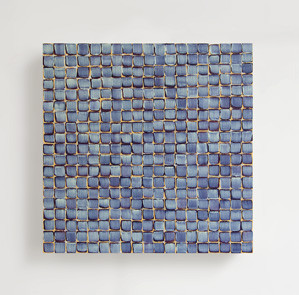
Sea of Stones (Quanta #42)
2012
Oil on board
15,2 x 15,2 x 2,3 cm /
6 x 6 ins
Titled, dated, signed verso:
Quanta 42 Sea of Stones
2012 Catherine Lee
2012
Oil on board
15,2 x 15,2 x 2,3 cm /
6 x 6 ins
Titled, dated, signed verso:
Quanta 42 Sea of Stones
2012 Catherine Lee
Galerie Karsten Greve is pleased to present the work of internationally renowned American artist Catherine Lee. Lee, who was born in 1950 in Pampa, Texas, creates work that reflects her fascination with the basic concept of abstract form and captivates viewers through the use of a wide variety of media, from monumental bronze sculptures to ceramics to small-format dra-wings on paper. The paintings that provide the focal point of this exhibition were created over the course of a long period of time, illustrating Lee’s constant engagement not only with mi-
nimalist principles of composition, but also with the phenomena of time and repetition, as well as with processes that remain the same over time. “My work is always serial, always repetitive; it’s a sort of marking of time, like a record of being in the world.” (Lee)
The most recent paintings, which are all part of the Quanta series, are displayed together with works from the 1970s. Lee’s artistic oeuvre is based on active repetition. The point of departure for her paintings is the grid, which she conceives of – similar to the grid used in cartography for geographical data – as the simplest means of orientation, and which she employs in structuring the picture plane. Lee feels that “It’s the most basic way of making order out of nothing.”
She connects the act of filling the individual cells of the grid structure with colour with multi- ple processes: on the one hand, with the passage of time, during the course of which all of the empty squares will be filled in. At the same time, the consistent application of layers of colour is like the regular, automatic rhythm of breathing. The consciously applied brushstroke be- comes an existential gesture. Just as time is divided into units that add up to hours, days and months, each square is similar to Lee, but not the same. She consciously tries to avoid including autobiographical traces in her painting, as well as the readability that is associated with a linear, narrative approach. As opposed to writing, which follows a movement from top to bot- tom and right to left and includes interruptions and pauses that interrupt the flow, the artist seeks to achieve equal treatment in the sense of a non-hierarchical whole.
Most of the titles refer to descriptions of the colours used, for example Madder Trumps Green, or to lines of her own poems (Immediate the Resonance of No). Each painting can be made up of just one colour or up to four, though Lee prefers to limit herself to two tones that enter into lively interaction with one another. The drawn grid is always entirely filled in with one mixed colour that covers the entire surface and is allowed to dry. Another mixed colour is layered on top, partially obscuring and actively informing the underlying hue, like a two-part harmony. The act of painting is a process of becoming – of making visible – that Catherine Lee sees as a form of meditation, among other things. Her awareness is concentrated to the highest possible degree: the slightest distraction could cause the brush in her hand to slip, leading to a loss of the painting. For Lee, every brushstroke is an affirmative gesture through which the act of painting fuses with her own current existence.
Another important medium for Catherine Lee is sculpture. Although the greater part of this exhibition is composed of paintings, a selection of her ceramic works is also on display.
These were executed using the raku firing technique. Silverbacks and Rift are also characterised by repetition, but embody an inherently different quality that is determined by the corporeality of the sculptural elements. This enables the viewer to perceive the volume of the object as well as the pictorial handling of the surface: the four-dimensional view of the “picture body”. These raku ceramic works were created during her tenure teaching at the Institute für Künstlerische Keramik und Glas. Lees work picks up on the tension that lies in the simultaneity of sameness and difference, of unity and individuality, and allows the overarching structure to enter into dynamic interaction with the manifold variations of the individual components. As in Lee’s paintings, the creative principle is the sequence of formally related adjoining units.
The concept of pure abstraction is central to Catherine Lee’s creative process and draws on her impressions of the landscape of her youth: “Where I grew up, the landscape was just nothing, it was flat, and there was nothing to stop the wind from blowing through an empty landscape. I ́m working from that all the time, a really reduced perspective, a sense of vastness, of space.” (Lee) Lee is not concerned with the abstraction of natural forms – reducing them to an expres- sion that remains bound to the original – but rather with her idea of spirituality. That the spiri- tual rather than the material constitutes the origin of all formation is the idea central to her oeuvre: “making something out of nothing.”(Lee)
Catherine Lee lives and works in New York and Texas. Her work can be found in many prestigious collections including the The San Francisco Museum of Art, The Museum of Fine Arts, Houston, The Museum of Modern Art in New York, as well as Tate Gallery in London. Exhibitions at the Lenbachhaus (Munich, 1992), Irish Museum of Modern Art (Dublin, 2005), the Musée d’Art Moderne La Terrasse (Saint Etienne, 2006) and the Hôtel des Arts (Toulon, 2006) brought her to the attention of the wider public. In addition to her teaching positions at the University of Texas in San Antonio (1983, 2000) and at Columbia University in New York (1986-87), in 2011 Lee was visiting professor at the IKKG Institut für Künstlerische Keramik und Glas, FH Koblenz (Höhr-Grenzhausen)
nimalist principles of composition, but also with the phenomena of time and repetition, as well as with processes that remain the same over time. “My work is always serial, always repetitive; it’s a sort of marking of time, like a record of being in the world.” (Lee)
The most recent paintings, which are all part of the Quanta series, are displayed together with works from the 1970s. Lee’s artistic oeuvre is based on active repetition. The point of departure for her paintings is the grid, which she conceives of – similar to the grid used in cartography for geographical data – as the simplest means of orientation, and which she employs in structuring the picture plane. Lee feels that “It’s the most basic way of making order out of nothing.”
She connects the act of filling the individual cells of the grid structure with colour with multi- ple processes: on the one hand, with the passage of time, during the course of which all of the empty squares will be filled in. At the same time, the consistent application of layers of colour is like the regular, automatic rhythm of breathing. The consciously applied brushstroke be- comes an existential gesture. Just as time is divided into units that add up to hours, days and months, each square is similar to Lee, but not the same. She consciously tries to avoid including autobiographical traces in her painting, as well as the readability that is associated with a linear, narrative approach. As opposed to writing, which follows a movement from top to bot- tom and right to left and includes interruptions and pauses that interrupt the flow, the artist seeks to achieve equal treatment in the sense of a non-hierarchical whole.
Most of the titles refer to descriptions of the colours used, for example Madder Trumps Green, or to lines of her own poems (Immediate the Resonance of No). Each painting can be made up of just one colour or up to four, though Lee prefers to limit herself to two tones that enter into lively interaction with one another. The drawn grid is always entirely filled in with one mixed colour that covers the entire surface and is allowed to dry. Another mixed colour is layered on top, partially obscuring and actively informing the underlying hue, like a two-part harmony. The act of painting is a process of becoming – of making visible – that Catherine Lee sees as a form of meditation, among other things. Her awareness is concentrated to the highest possible degree: the slightest distraction could cause the brush in her hand to slip, leading to a loss of the painting. For Lee, every brushstroke is an affirmative gesture through which the act of painting fuses with her own current existence.
Another important medium for Catherine Lee is sculpture. Although the greater part of this exhibition is composed of paintings, a selection of her ceramic works is also on display.
These were executed using the raku firing technique. Silverbacks and Rift are also characterised by repetition, but embody an inherently different quality that is determined by the corporeality of the sculptural elements. This enables the viewer to perceive the volume of the object as well as the pictorial handling of the surface: the four-dimensional view of the “picture body”. These raku ceramic works were created during her tenure teaching at the Institute für Künstlerische Keramik und Glas. Lees work picks up on the tension that lies in the simultaneity of sameness and difference, of unity and individuality, and allows the overarching structure to enter into dynamic interaction with the manifold variations of the individual components. As in Lee’s paintings, the creative principle is the sequence of formally related adjoining units.
The concept of pure abstraction is central to Catherine Lee’s creative process and draws on her impressions of the landscape of her youth: “Where I grew up, the landscape was just nothing, it was flat, and there was nothing to stop the wind from blowing through an empty landscape. I ́m working from that all the time, a really reduced perspective, a sense of vastness, of space.” (Lee) Lee is not concerned with the abstraction of natural forms – reducing them to an expres- sion that remains bound to the original – but rather with her idea of spirituality. That the spiri- tual rather than the material constitutes the origin of all formation is the idea central to her oeuvre: “making something out of nothing.”(Lee)
Catherine Lee lives and works in New York and Texas. Her work can be found in many prestigious collections including the The San Francisco Museum of Art, The Museum of Fine Arts, Houston, The Museum of Modern Art in New York, as well as Tate Gallery in London. Exhibitions at the Lenbachhaus (Munich, 1992), Irish Museum of Modern Art (Dublin, 2005), the Musée d’Art Moderne La Terrasse (Saint Etienne, 2006) and the Hôtel des Arts (Toulon, 2006) brought her to the attention of the wider public. In addition to her teaching positions at the University of Texas in San Antonio (1983, 2000) and at Columbia University in New York (1986-87), in 2011 Lee was visiting professor at the IKKG Institut für Künstlerische Keramik und Glas, FH Koblenz (Höhr-Grenzhausen)
